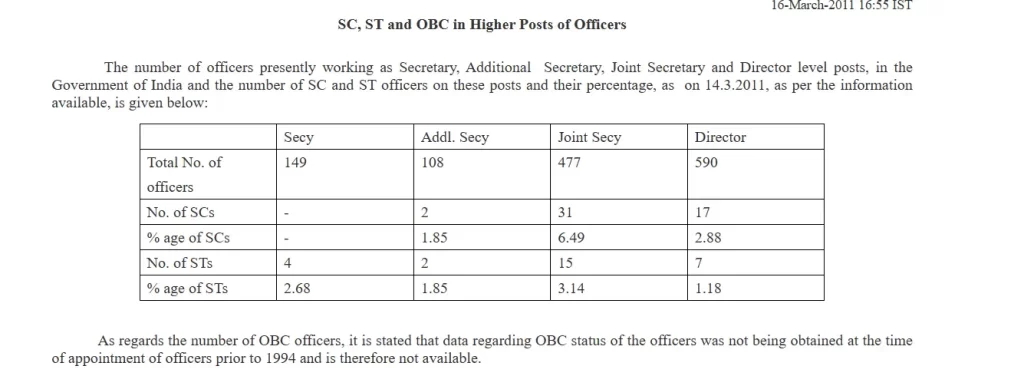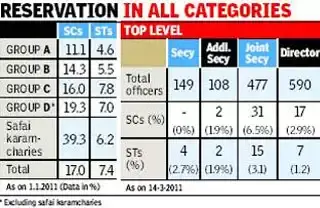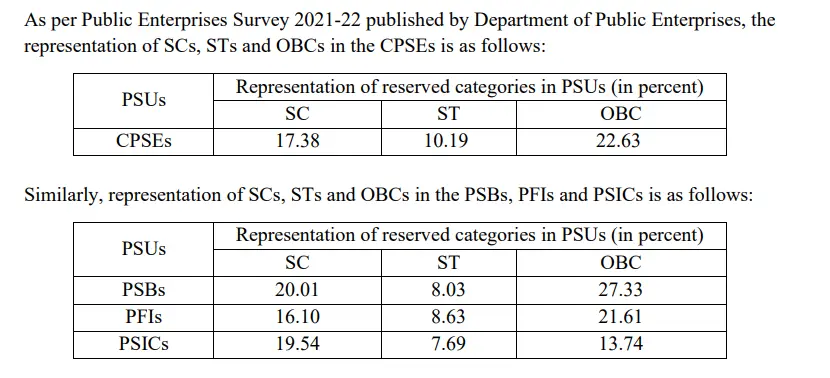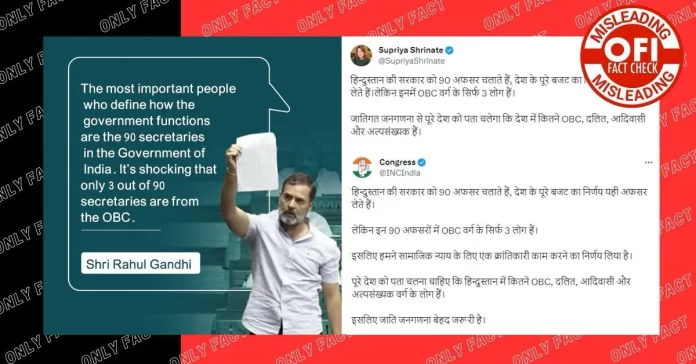Rahul Gandhi’s Bharat Nyay Yatra has now reached Bihar, where he has once again championed the cause of a caste-based census. The contentious issue of a caste census originated in Bihar, with promises from the INDI alliance leaders to conduct it nationwide once in power. However, much like previous commitments from the opposition, this assurance has been criticized for being opportunistic and merely aimed at appeasement. Recently, the Congress party drew attention to alleged discrimination against the Other Backward Classes (OBC) by citing data from an article published by left-leaning media outlet, The Print.
The party asserted that among the 90 secretaries, a mere three belonged to the OBC category. Recently, in a rhetorical statement, Rahul Gandhi emphasized that out of the 90 officials overseeing crucial aspects of the country’s administration and budget allocation, only three hailed from the OBC community.
"It's shocking that only 3 out of 90 secretaries are from the OBC." pic.twitter.com/15ccFgnO5u
— Congress (@INCIndia) September 20, 2023
हिन्दुस्तान की सरकार को 90 अफसर चलाते हैं, देश के पूरे बजट का निर्णय यही अफसर लेते हैं।
— Congress (@INCIndia) January 29, 2024
लेकिन इन 90 अफसरों में OBC वर्ग के सिर्फ 3 लोग हैं।
इसलिए हमने सामाजिक न्याय के लिए एक क्रांतिकारी काम करने का निर्णय लिया है।
पूरे देश को पता चलना चाहिए कि हिन्दुस्तान में कितने OBC,… pic.twitter.com/40Vvtfkwhl
हिन्दुस्तान की सरकार को 90 अफसर चलाते हैं, देश के पूरे बजट का निर्णय यही अफसर लेते हैं।लेकिन इनमें OBC वर्ग के सिर्फ 3 लोग हैं।
— Supriya Shrinate (@SupriyaShrinate) January 29, 2024
जातिगत जनगणना से पूरे देश को पता चलेगा कि देश में कितने OBC, दलित, आदिवासी और अल्पसंख्यक हैं। @RahulGandhi
📍 बिहार
pic.twitter.com/MPY8OIWTxA
Upon closer examination of the statistics, it is evident that close to half of the population is affiliated with the Other Backward Classes (OBC). However, the assertions made by Rahul Gandhi and the Congress, contending that a mere three officials from the OBC community wield influence over public policy decisions, portray a scenario of profound injustice. Consequently, this article aims to dissect the intricacies of these numerical representations, shedding light on the accuracy of the opposition’s allegations and offering a comprehensive understanding of the situation.
Also Read: Claim About PM Narendra Modi’s Family Benefitting From His Position And Gaining Wealth is False
Fact Check
1- Intentional Misinterpretation of Numerical Data
To provide a comprehensive view of the representation of the Other Backward Classes (OBC) at the secretary level in central government positions, data from 2015 is incorporated. According to a PIB press release, out of 70 secretaries, none belonged to the OBC category, while 3 each were from the Scheduled Castes (SC) and Scheduled Tribes (ST). The statistics reveal that only 10 joint secretaries out of 278, and 10 deputy secretaries out of 45, hailed from the OBC community. In comparison, 24 and 10 joint secretaries were from the SC and ST communities respectively, and 4 and 3 deputy secretaries were from the SC and ST communities respectively.
An important caveat accompanies these numbers: “Details of officers recruited under the general category prior to the introduction of OBC quota are not maintained.” This caveat underscores the complexity of assessing historical data.

In 1992, the Supreme Court of India affirmed the 27 percent reservation for the Other Backward Classes in central government services. However, it’s crucial to note that this reservation doesn’t imply the absence of OBC individuals in central government roles before 1992. Many OBC employees existed but were categorized under the general category. The official categorization as OBC only began in 1994.
Moreover, to qualify for an additional secretary position in the central government, an IAS officer is required to accumulate 25 years of experience. Similarly, a joint secretary needs 15 years of experience, and a deputy secretary needs 7 years. This explains why the 2015 PIB data lacks a caveat for the deputy secretary post, where more than 22 percent of candidates come from the Other Backward Classes (OBC). The shorter experience requirement makes it plausible for OBC IAS officers to get deputy secretary post , after the implementation of the OBC quota in 1992/94.
However, a noticeable disparity emerges in the sparse representation of OBC IAS officers in additional secretary and joint secretary roles. This discrepancy is attributed to historical categorization challenges, as before 1992, OBC IAS officers were classified under the general category.
2- Surge in Representation: OBC and SC/ST IAS Officers Numbers on the Rise
The Print, in August 2019, published an article shortly after the Government of India released data on the representation of OBC, SC, and ST at the secretary level. However, the figures provided by the government in July 2019 present a contrasting narrative. According to the press release, covering 78 Ministries/Departments along with their attached/subordinate offices, the representation of SCs, STs, and OBCs in the Central Government posts and services as of January 1, 2016, stood at 17.49%, 8.47%, and 21.57%, respectively.
While SCs and STs exceeded the prescribed reservation percentages (15% and 7.5%, respectively), the representation of OBCs fell short of the 27% reservation. Nevertheless, the data highlights a positive trend in OBC representation, increasing from 16.55% in 2012 to 21.57% in 2016.

Moreover, the data from 2020 underscores significant progress, with reservation rates at 15%, 7.5%, and 27% for SCs, STs, and OBCs, respectively. The representation of SCs and STs in both direct recruitment and promotions surpasses the prescribed percentages, and OBC representation in direct recruitment exceeds 27%. As of January 1, 2020, the number of SCs, STs, and OBCs in various Ministries/Departments stands at 5,44,493; 2,75,114; and 7,61,240, respectively.
Comparing the figures from 2016 to 2020 underscores a substantial increase in the representation of OBCs, SCs, and STs in central government jobs, suggesting a noteworthy positive trend since the inception of the Modi government.
3- Abysmal Representation of OBC/SC/ST during the Congress rule
The provided data vividly illustrates the evolution of representation over the years. In 2012, OBC representation stood at only 16.55%. Furthermore, during the Congress rule in 2011, there were no SC secretaries, only four from the ST community, two additional secretaries each from SC/ST, and a mere 31 SC and 15 ST joint secretaries out of 477. The directors’ positions showed a similar trend, with only 17 allocated to SC and seven to ST out of 590 posts.

Notably, data on the OBC status of officers appointed before 1994 is unavailable. An article from The Economic Times in 2011 reported no SC secretaries and only four ST secretaries out of a total of 149 at that time.

Despite constitutional provisions mandating 15% and 7.5% representation from SC and ST communities since the inception of the Indian constitution, the 2012 Congress government revealed stark disparities. In secretary-level positions, there were no SC officers, only 2.68% from the ST community, and meager percentages in additional secretary and joint secretary roles for both SC and ST communities. The percentage of directors from the SC/ST community also remained significantly low.
4- Debunking Rahul Gandhi’s Rhetorics
During the Bharat Nyay Yatra, Rahul Gandhi asserted that a mere three OBC officers are tasked with budget allocation and overseeing the government’s monetary policies, implying insufficient representation in these critical decision-making roles. However, in March 2023, Finance Minister Nirmala Sitharaman highlighted a different perspective, stating that PSU representation includes 17.38% from the SC community, 10.19% from the ST community, and 22.63% from the OBC community.

Conclusion:
The data provided by the Congress party appears antiquated and reflective of a bygone era, much like the party itself. The apparent scarcity of OBC IAS officers at the secretary level post can be attributed to the fact that OBC categorization became a norm only after 1994. Consequently, considering the substantial experience, ranging from 15 to 25 years, required for secretary-level positions, the pool of IAS officers benefiting from the OBC quota was naturally limited.
However, the scenario differs for deputy secretary roles, where only seven years of experience are needed. In 2015, the data indicates a notable presence of OBC officers, constituting 22.22% of deputy secretaries. It’s crucial to recognize that the seemingly lower numbers of OBC secretaries are a result of methodological considerations, and it does not imply that IAS officers from the backward class were not promoted to secretary-level positions before the 1994 batch.
Furthermore, the data from 2016 and 2020 underscores a substantial uptick in the presence of IAS officers hailing from the OBC, SC, and ST communities. This trend aligns with the overarching theme of holistic development advocated by the Modi government, emphasizing inclusivity from every community. The Congress party’s attempt to mislead the largest demographic in India appears evident, as it seeks to bolster its voter base.
| Claim | Only 3 OBC secretaries work under the central government |
| Claimed by | Congress and Rahul Gandhi |
| Fact Check | Misleading |
Also Read: Sanjiv Bhatt Distorted Heroism: Debunking Sadaf Afreen’s Attempt to Glorify Him









